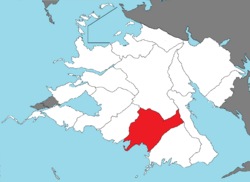Tregueux (Province): Difference between revisions
No edit summary |
No edit summary |
||
| Line 29: | Line 29: | ||
|leader_title3 = | |leader_title3 = | ||
|leader_name3 = | |leader_name3 = | ||
| | |population_total = 15,336,000 | ||
}} | }} | ||
Revision as of 01:22, 26 August 2022
Tregueux | |
|---|---|
 Tregueux located in Zamastan | |
| Country | Zamastan |
| Capital and largest city | Tregueux |
| Province | March 4th, 1886 |
| Government | |
| • Governor | Morriane Wilkons (GLP) |
| Population | |
| • Total | 15,336,000 |
Tregueux is a province of Zamastan, bordered to the west by Landeda, to the north by Pahl, to the east by Alutiana and Alenchon, with a southern coastline along the Cantalle Ocean. The province's namesake capital and largest city is Tregueux, with other notable cities being Walsboro, Woodmont, Dalston, Salland, and Chilport. Tregueux is almost entirely within the Cantalle coastal plain, and generally consists of lowland plains and low hills. The northwest remainder of the province consists of the Covenpool Delta, a section of the Addle Alluvial Plain. Tregueux has a humid subtropical climate.
Inhabited for thousands of years by indigenous southwestern Euronians, the coastal region of present-day Tregueux was colonized by the Quetanan and later Skithan empires, producing cotton, sugar, and tobacco, with slaves accounting for 55% of the population. After the expulsion of colonizers in 1810, a residual effect of the War of Independence, Tregueux became its own nation, the Tregueux Federation, for a brief period from 1810-32, but poor cooperation between different settlements of freed-slaves and abolitionist founders led to the federation's collapse, and the region was largely unincorporated and ungoverned. The Tregueux Territory Annexation of 1881 under President William Castovia resulted in the province of Tregueux being established on March 4th, 1886. In the early 20th century, despite the growth of major industries and urban centers, white rural interests dominated the state legislature through the mid-20th century. During this time, urban interests, and both racial and sexual minority populations were markedly under-represented. High-profile events such as the Campleche march made the province a major focal point of the civil rights movements. During and after the World War, Tregueux grew as the province's economy diversified with new industries. In 2001, Hurricane Alberta caused major damage along the coast in one of the worst natural disasters in the nation's history.
Tregueux province frequently ranks low among states in measures of health, education, and development, while ranking high in measures of poverty. Tregueux's economy is based around automotive, finance, manufacturing, mineral extraction, healthcare, education, retail, and technology. Tregueux is also a large agricultural producer, producing more than half of the country's farm-raised fish, sweet potatoes, cotton and pulpwood. The aerospace industry is also a major sector, as the Zamastanian Space Agency headquarters its main launch site, the Tregueux International Space Center, in the province. Tourism is an emerging industry, mostly on the coastal region.